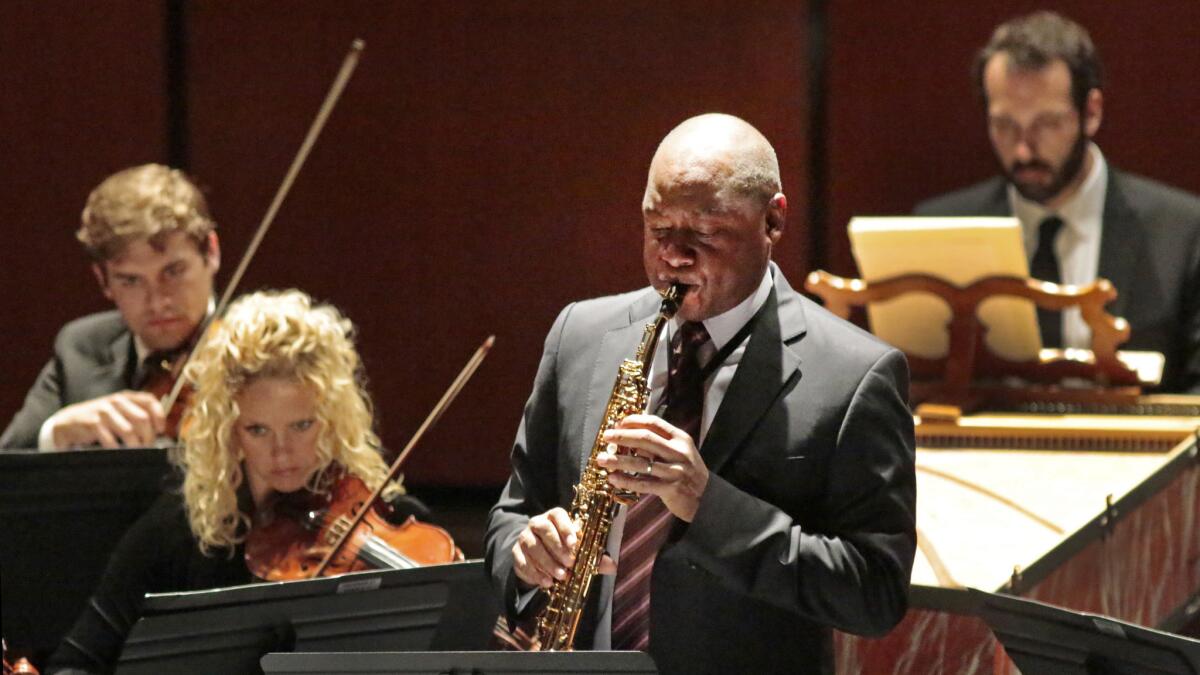Review: Marsalis, Philadelphia orchestra go by the book at the Wallis

Branford Marsalis can be a beguiling saxophonist, whether as a jazz player, a pop musician or, increasingly, in the classical repertory.
In the latter, he has distinguished himself particularly in French and Russian saxophone concertos, and he has also inspired new American concert works. Now he has attempted to beguile with the Baroque.
Touring with the Chamber Orchestra of Philadelphia in a program of French, German and Italian Baroque pieces called “Well-Tempered,” Marsalis made a stop Thursday night at the Wallis Annenberg Center for the Performing Arts.
Not only does Marsalis express an obvious respect for the music, he has the potential to bring something useful to it. He modernizes the sound by transcribing oboe or violin solos for saxophone, and he has the background to restore improvisation to Baroque performance, which was common in the 17th century.
There is, of course, a long and wonderful tradition of jazz absorbing and animating Baroque music, especially with Bach, which goes back to the Modern Jazz Quartet and before. But Marsalis is more concerned with playing it straight.
And straight, straitjacket straight, is how he played it Thursday in a concert that, thanks to a few unfortunate coincidences, became almost a textbook example of how not to present Baroque music.
First, there was the Wallis, which has begun its second season with its founding director having just stepped down. On this evening, audiences in the generously proportioned 500-seat Beverly Hills venue were kept in a nearly pitch-black hall much of the night. Even the stage was poorly lighted for the first part of the show.
Although the evening included rarities, reading the program, printed in light type on glossy paper, in the dark was out of the question. Not that there was much to read. There were no notes on the music, and individual movements weren’t listed.
The chamber orchestra of 19 string players and harpsichord were placed at the rear of the stage with the harpsichord up against the back wall of the shell, which created a boomy string sound, minimal presence for the keyboard and a general lack of intimacy all around.
There was no conductor. The Philadelphians are experienced (the ensemble was formed 50 years ago, although the current membership looks young), but its music director wasn’t present. The musical style was corporate, phrasing and balance decisions obviously made in rehearsal and adhered to in performance, with little or no room for spontaneity. Marsalis led nominally in the works in which he performed, but he faced the audience and concentrated on the music stand in front of him.
The program itself was wide-ranging yet curiously tame. It began cliché-like, with the Air from Bach’s Third Orchestral Suite (commonly known as Air on a G-String) blandly played. Marsalis was soloist in two concertos, one by Albinoni (Opus 9, No. 5) originally for oboe, and one by Bach (BWV 1013) for harpsichord that scholars suspect was originally also for oboe. Marsalis transcribed them for saxophone, the Bach being a kind of double reworking, since Marsalis used a reconstruction of the original oboe version as his starting point.
The saxophone — sweet, urban, loud, intriguingly lurid — offers far different pleasures than those found in the more delicate oboe. Balances need rethinking, but they weren’t rethought. Harpsichord and sax make an odd couple, unless amplification is employed to give the quiet keyboard equal prominence. Harpsichordist Raphael Fusco seemed like a lively player when he could be heard, which wasn’t often and never fully.
If Marsalis improvised, it may have been in a few melodic embellishments, as Bach and Albinoni would have done themselves. But the performances were mainly by the book, lacking a sense of personality or interpretation. A conductor could have made all the difference. Still, Marsalis did have his singular moments, the best being his seductive rise up the chromatic scale in the Siciliano slow movement of the Bach.
The saxophonist was more at home in two French trios (with harpsichord and cello), the first of Couperin’s “Concerts Royaux” and an oboe sonata by Louis-Antoine Dornel, a little-remembered contemporary of Bach. Here the saxophone sounded suitable, and so was Marsalis’ smooth lyricism. His lithe melodic embellishments worked, given that Couperin, in particular, presages a kind of French Baroque bebop to begin with. But again, the poor harpsichord stood no acoustic chance.
On its own the orchestra, sewing machine-steady, offered a concerto grosso by Locatelli (Opus 1, No. 6) and Telemann’s characterful suite from “Don Quixote,” although the audience, with no program notes, was left in the dark as to what might have been meant to represent the Don’s attack on windmills or Princess Dulcinea’s sighs.
The encores were a movement from a CPE Bach concerto and, with an orchestra bass player and harpsichord, “Autumn Leaves.” It turns out Fusco is a fine improviser. Now if Marsalis could beguile the rest of the orchestra to swing like that, and they get him to swing in the Baroque, the collaboration could, as it did not Thursday, work.
Twitter: @markswed
More to Read
The biggest entertainment stories
Get our big stories about Hollywood, film, television, music, arts, culture and more right in your inbox as soon as they publish.
You may occasionally receive promotional content from the Los Angeles Times.











